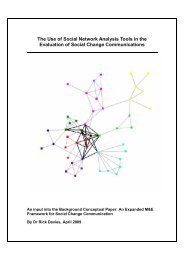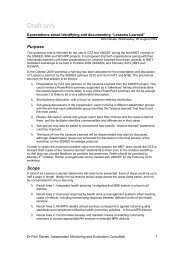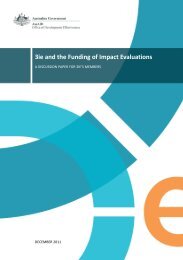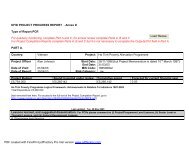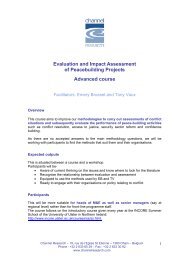Methodology checklist: qualitative studies - National Institute for ...
Methodology checklist: qualitative studies - National Institute for ...
Methodology checklist: qualitative studies - National Institute for ...
Create successful ePaper yourself
Turn your PDF publications into a flip-book with our unique Google optimized e-Paper software.
The guidelines manual (appendices)<br />
Appendix I: <strong>Methodology</strong> <strong>checklist</strong>: <strong>qualitative</strong><br />
<strong>studies</strong> 1<br />
Study identification<br />
Include author, title, reference, year of<br />
publication<br />
Guidance topic:<br />
Key research question/aim:<br />
Checklist completed by:<br />
Section 1: theoretical approach<br />
1.1 Is a <strong>qualitative</strong> approach appropriate<br />
For example:<br />
• Does the research question seek to<br />
understand processes or structures, or<br />
illuminate subjective experiences or<br />
meanings<br />
• Could a quantitative approach better have<br />
addressed the research question<br />
1.2 Is the study clear in what it seeks to do<br />
For example:<br />
• Is the purpose of the study discussed –<br />
aims/objectives/research question(s)<br />
• Is there adequate/appropriate reference to<br />
the literature<br />
• Are underpinning values/assumptions/theory<br />
discussed<br />
Appropriate<br />
Inappropriate<br />
Not sure<br />
Clear<br />
Unclear<br />
Mixed<br />
Comments:<br />
Comments:<br />
1 This <strong>checklist</strong> is based on <strong>checklist</strong>s in:<br />
Spencer L. Ritchie J, Lewis J, Dillon L (2003) Quality in <strong>qualitative</strong> evaluation: a framework <strong>for</strong><br />
assessing research evidence. London: Government Chief Social Researcher’s Office. Available from:<br />
www.strategy.gov.uk/downloads/su/qual/downloads/qqe_rep.pdf<br />
Public Health Resource Unit England (2006) Critical Appraisal Skills Programme (CASP) – making<br />
sense of evidence: 10 questions to help you make sense of <strong>qualitative</strong> research . Available from:<br />
www.phru.nhs.uk/Doc_Links/Qualitative%20Appraisal%20Tool.pdf<br />
<strong>National</strong> Training and Research Appraisal Group (NTRAG); contact: www.ntrag.co.uk<br />
British Sociological Association (BSA); contact: www.britsoc.co.uk<br />
I <strong>Methodology</strong> <strong>checklist</strong>: <strong>qualitative</strong> <strong>studies</strong><br />
© <strong>National</strong> <strong>Institute</strong> <strong>for</strong> Health and Clinical Excellence (January 2009) Page 208 of 266
The guidelines manual (appendices)<br />
Section 2: study design<br />
2.1 How defensible/rigorous is the research<br />
design/methodology<br />
For example:<br />
• Is the design appropriate to the research<br />
question<br />
• Is a rationale given <strong>for</strong> using a <strong>qualitative</strong><br />
approach<br />
• Are there clear accounts of the<br />
rationale/justification <strong>for</strong> the sampling, data<br />
collection and data analysis techniques<br />
used<br />
• Is the selection of cases/sampling strategy<br />
theoretically justified<br />
Defensible<br />
Not defensible<br />
Not sure<br />
Comments:<br />
Section 3: data collection<br />
3.1 How well was the data collection carried<br />
out<br />
For example:<br />
• Are the data collection methods clearly<br />
described<br />
• Were the appropriate data collected to<br />
address the research question<br />
• Was the data collection and record keeping<br />
systematic<br />
Appropriate<br />
Inappropriate<br />
Not sure/<br />
inadequately<br />
reported<br />
Comments:<br />
I <strong>Methodology</strong> <strong>checklist</strong>: <strong>qualitative</strong> <strong>studies</strong><br />
© <strong>National</strong> <strong>Institute</strong> <strong>for</strong> Health and Clinical Excellence (January 2009) Page 209 of 266
The guidelines manual (appendices)<br />
Section 4: validity<br />
4.1 Is the role of the researcher clearly<br />
described<br />
For example:<br />
• Has the relationship between the researcher<br />
and the participants been adequately<br />
considered<br />
• Does the paper describe how the research<br />
was explained and presented to the<br />
participants<br />
4.2 Is the context clearly described<br />
For example:<br />
• Are the characteristics of the participants<br />
and settings clearly defined<br />
• Were observations made in a sufficient<br />
variety of circumstances<br />
• Was context bias considered<br />
4.3 Were the methods reliable<br />
For example:<br />
• Were data collected by more than one<br />
method<br />
• Is there justification <strong>for</strong> triangulation, or <strong>for</strong><br />
not triangulating<br />
• Do the methods investigate what they claim<br />
to<br />
Clear<br />
Unclear<br />
Not described<br />
Clear<br />
Unclear<br />
Not sure<br />
Reliable<br />
Unreliable<br />
Not sure<br />
Comments:<br />
Comments:<br />
Comments:<br />
I <strong>Methodology</strong> <strong>checklist</strong>: <strong>qualitative</strong> <strong>studies</strong><br />
© <strong>National</strong> <strong>Institute</strong> <strong>for</strong> Health and Clinical Excellence (January 2009) Page 210 of 266
The guidelines manual (appendices)<br />
Section 5: analysis<br />
5.1 Is the data analysis sufficiently<br />
rigorous<br />
For example:<br />
• Is the procedure explicit – is it clear how the<br />
data were analysed to arrive at the results<br />
• How systematic is the analysis – is the<br />
procedure reliable/dependable<br />
• Is it clear how the themes and concepts<br />
were derived from the data<br />
5.2 Are the data ‘rich’<br />
For example:<br />
• How well are the contexts of the data<br />
described<br />
• Has the diversity of perspective and content<br />
been explored<br />
• How well have the detail and depth been<br />
demonstrated<br />
• Are responses compared and contrasted<br />
across groups/sites<br />
5.3 Is the analysis reliable<br />
For example:<br />
• Did more than one researcher theme and<br />
code transcripts/data<br />
• If so, how were differences resolved<br />
• Did participants feed back on the<br />
transcripts/data (if possible and relevant)<br />
• Were negative/discrepant results addressed<br />
or ignored<br />
5.4 Are the findings convincing<br />
For example:<br />
• Are the findings clearly presented<br />
• Are the findings internally coherent<br />
• Are extracts from the original data included<br />
• Are the data appropriately referenced<br />
• Is the reporting clear and coherent<br />
5.5 Are the findings relevant to the aims of<br />
the study<br />
Rigorous<br />
Not rigorous<br />
Not sure/not<br />
reported<br />
Rich<br />
Poor<br />
Not sure/not<br />
reported<br />
Reliable<br />
Unreliable<br />
Not sure/not<br />
reported<br />
Convincing<br />
Not convincing<br />
Not sure<br />
Relevant<br />
Irrelevant<br />
Comments:<br />
Comments:<br />
Comments:<br />
Comments:<br />
Comments:<br />
Partially relevant<br />
5.6 Are the conclusions adequate Adequate<br />
Comments:<br />
I <strong>Methodology</strong> <strong>checklist</strong>: <strong>qualitative</strong> <strong>studies</strong><br />
© <strong>National</strong> <strong>Institute</strong> <strong>for</strong> Health and Clinical Excellence (January 2009) Page 211 of 266
The guidelines manual (appendices)<br />
For example:<br />
• How clear are the links between data,<br />
interpretation and conclusions<br />
• Are the conclusions plausible and coherent<br />
• Have alternative explanations been explored<br />
and discounted<br />
• Does this study enhance understanding of<br />
the research subject<br />
• Are the implications of the research clearly<br />
defined<br />
• Is there adequate discussion of any<br />
limitations encountered<br />
Section 6: ethics<br />
6.1 How clear and coherent is the reporting<br />
of ethical considerations<br />
For example,<br />
• Have ethical issues been taken into<br />
consideration<br />
• Are ethical issues discussed adequately –<br />
do they address consent and anonymity<br />
• Have the consequences of the research<br />
been considered; <strong>for</strong> example, raising<br />
expectations, changing behaviour<br />
• Was the study approved by an ethics<br />
committee<br />
Inadequate<br />
Not sure<br />
Clear<br />
Not clear<br />
Not sure/not<br />
reported<br />
Comments:<br />
I <strong>Methodology</strong> <strong>checklist</strong>: <strong>qualitative</strong> <strong>studies</strong><br />
© <strong>National</strong> <strong>Institute</strong> <strong>for</strong> Health and Clinical Excellence (January 2009) Page 212 of 266
The guidelines manual (appendices)<br />
Notes on use of <strong>Methodology</strong> <strong>checklist</strong>: <strong>qualitative</strong> <strong>studies</strong><br />
There is considerable debate over which quality criteria should be used to<br />
assess <strong>qualitative</strong> <strong>studies</strong>. Quality in <strong>qualitative</strong> research can be assessed<br />
using the same broad concepts of validity (or trustworthiness) used <strong>for</strong><br />
quantitative research, but these need to be put in a different contextual<br />
framework to take into account the aims of <strong>qualitative</strong> research.<br />
This <strong>checklist</strong> is designed <strong>for</strong> people with a basic understanding of <strong>qualitative</strong><br />
research methodology, and is based on the broadly accepted principles that<br />
characterise <strong>qualitative</strong> research and that may affect its validity. The following<br />
notes provide suggestions <strong>for</strong> completing the <strong>checklist</strong>. A list of publications<br />
on <strong>qualitative</strong> research is provided at the end of these notes <strong>for</strong> further<br />
reading on this topic.<br />
The <strong>studies</strong> covered by this <strong>checklist</strong> are those that collect and analyse<br />
<strong>qualitative</strong> data – usually (but not exclusively) textual (written), spoken or<br />
observational data. Qualitative data are occasionally collected using<br />
structured questionnaires (<strong>for</strong> example, as thematically organised free-text<br />
comments), but such research needs to be scrutinised carefully, as it may not<br />
meet acceptable quality criteria <strong>for</strong> consideration as a <strong>qualitative</strong> study.<br />
The questions in the <strong>checklist</strong> are framed to encompass the variety of ways in<br />
which <strong>qualitative</strong> research is conducted. Care must be taken to apply the<br />
<strong>checklist</strong> in a way that matches the research methodology.<br />
Note that the sub-questions given as examples under each question in the<br />
<strong>checklist</strong> are intended to highlight some of the key issues to be considered <strong>for</strong><br />
that question – they are not intended to be exhaustive. Please add any<br />
additional considerations in the comments box.<br />
Section 1: theoretical approach<br />
This section deals with the underlying theory and principles applied to the<br />
research.<br />
1.1 Is a <strong>qualitative</strong> approach appropriate<br />
A <strong>qualitative</strong> approach can be judged to be appropriate when the research<br />
sets out to investigate phenomena that are not easy to quantify or measure<br />
accurately, or where such measurement would be arbitrary and inexact. If<br />
clear numerical measures could reasonably have been put in place, then<br />
consider whether a quantitative approach may have been more appropriate.<br />
Qualitative research in public health commonly measures:<br />
• personal experiences (<strong>for</strong> example, of a condition, treatment or situation)<br />
• processes (<strong>for</strong> example, action research, practitioner or patient views on<br />
the acceptability of using new technology)<br />
• personal values and beliefs (<strong>for</strong> example, about death, birth, disability)<br />
• interactions and relationships (<strong>for</strong> example, the quality of the GP–patient<br />
relationship, the openness of a psychotherapeutic relationship)<br />
I <strong>Methodology</strong> <strong>checklist</strong>: <strong>qualitative</strong> <strong>studies</strong><br />
© <strong>National</strong> <strong>Institute</strong> <strong>for</strong> Health and Clinical Excellence (January 2009) Page 213 of 266
The guidelines manual (appendices)<br />
• service evaluations (<strong>for</strong> example, what was good or bad about patients’<br />
experiences of a smoking cessation group).<br />
1.2 Is the study clear in what it seeks to do<br />
The design of <strong>qualitative</strong> research tends to be ‘theory generative’ rather than<br />
‘theory testing’; it is there<strong>for</strong>e unlikely that a research question will be found in<br />
the <strong>for</strong>m of a hypothesis or null hypothesis in the way that you would expect in<br />
traditional quantitative research. Nevertheless, the paper should still set out<br />
early and clearly what the study is investigating and what the parameters are.<br />
The research question should be set in context by the provision of an<br />
adequate summary of the background literature and the study’s underpinning<br />
values and assumptions.<br />
Section 2: study design<br />
This section considers the robustness of the design of the research project.<br />
2.1 How defensible/rigorous is the research design/methodology<br />
There are a large number of <strong>qualitative</strong> methodologies, and a tendency in<br />
healthcare <strong>studies</strong> to ‘mix’ aspects of different methodologies or to use a<br />
generic <strong>qualitative</strong> method. From a <strong>qualitative</strong> perspective, none of this<br />
compromises the quality of the study as long as the following criteria are<br />
fulfilled:<br />
• The research design should capture appropriate data and have an<br />
appropriate plan of analysis <strong>for</strong> the subject under investigation. There<br />
should be a clear and reasonable justification <strong>for</strong> the methods chosen.<br />
• The choice of sample and sampling method should be clearly set out<br />
(ideally including any shortcomings of the sample) and should be<br />
reasonable. It is important to remember that sampling in <strong>qualitative</strong><br />
research can be purposive and should not be random. Qualitative research<br />
is not experimental and does not purport to be generalisable, and there<strong>for</strong>e<br />
does not require a large or random sample. People are usually ‘chosen’ <strong>for</strong><br />
<strong>qualitative</strong> research based on being key in<strong>for</strong>mers.<br />
Section 3: data collection<br />
3.1 How well was the data collection carried out<br />
Were the methods of data collection used the most appropriate, given the<br />
aims of the research Was the data collection robust, and are there details of:<br />
• how the data were collected<br />
• how the data were recorded and transcribed (if verbal data)<br />
• how the data were stored<br />
• what records were kept of the data collection<br />
Section 4: validity<br />
Assessing the validity of <strong>qualitative</strong> research is very different from assessing<br />
that of quantitative research. Qualitative research is much more focused on<br />
demonstrating the causes of bias rather than eliminating them. It is there<strong>for</strong>e<br />
good practice to include sections in the report about the reflexive position of<br />
I <strong>Methodology</strong> <strong>checklist</strong>: <strong>qualitative</strong> <strong>studies</strong><br />
© <strong>National</strong> <strong>Institute</strong> <strong>for</strong> Health and Clinical Excellence (January 2009) Page 214 of 266
The guidelines manual (appendices)<br />
the researcher (their ‘role’ in the research), the context in which the research<br />
was conducted and the reliability of the actual data.<br />
4.1 Is the role of the researcher clearly described<br />
The researcher should have considered their role in the research; <strong>for</strong><br />
example, as a reader, interviewer or observer. This is often referred to as<br />
‘reflexivity’. The ‘status’ of the researcher can profoundly affect the data. For<br />
example, a middle-aged woman and an 18-year-old man are likely to get<br />
different responses to questions about sexual activity when interviewing a<br />
group of teenage boys. It is important to consider age, sex, ethnicity and<br />
‘insider’ status (such as where the interviewer or researcher is part of the<br />
group being researched or has the same condition or illness). The researcher<br />
can also profoundly influence the data by use of questions, opinions,<br />
judgements and so on, so it is important to know what the researcher’s<br />
position is in this regard, and how the researcher introduced and talked about<br />
the research with the participants.<br />
4.2 Is the context clearly described<br />
It is important when gauging the validity of <strong>qualitative</strong> data to engage with the<br />
data in a meaningful way, and to consider whether the data are plausible and<br />
realistic. To make an accurate assessment of this, it is important to have a<br />
good feeling <strong>for</strong> the context of the research in terms of the physical context<br />
(<strong>for</strong> example, youth club, GP surgery, gang headquarters) and who else was<br />
there (<strong>for</strong> example, participants are likely to position themselves very<br />
differently, and thus to respond very differently, in a discussion with parents<br />
present compared with a discussion with peers present). You should also feel<br />
that the participants are described in enough detail that the reader can have<br />
some sort of insight into their life and situation. Any potential context bias<br />
should be considered.<br />
4.3 Were the methods reliable<br />
It is important that the method used to collect the data is appropriate <strong>for</strong> the<br />
research question, and that the data generated map well to the aims of the<br />
study. Ideally, more than one method should have been used to collect data,<br />
or there should be some other kind of system of comparison that allows the<br />
data to be compared. This is referred to as ‘triangulation’.<br />
Section 5: analysis<br />
Qualitative data analysis is very different from quantitative analysis. This does<br />
not mean that it should not be systematic and rigorous; however,<br />
systematisation and rigour require different methods of assessment.<br />
5.1 Is the data analysis sufficiently rigorous<br />
The main way to assess this is by how clearly the analysis is reported and<br />
whether the analysis is approached systematically. There should be a clear<br />
and consistent method <strong>for</strong> coding and analysing data, and it should be clear<br />
how the coding and analytical strategies were derived. Above all, these must<br />
be reasonable in light of the evidence and the aims of the study.<br />
Transparency is the key to addressing the rigour of the analysis.<br />
I <strong>Methodology</strong> <strong>checklist</strong>: <strong>qualitative</strong> <strong>studies</strong><br />
© <strong>National</strong> <strong>Institute</strong> <strong>for</strong> Health and Clinical Excellence (January 2009) Page 215 of 266
The guidelines manual (appendices)<br />
5.2 Are the data ‘rich’<br />
Qualitative researchers use the adjective ‘rich’ to describe data that are indepth,<br />
convincing, compelling and detailed enough that the reader feels that<br />
they have achieved some level of insight into the research participants’<br />
experience. It is also important to know the ‘context’ of the data – where they<br />
came from, what prompted them, what they pertains to, and so on.<br />
5.3 Is the analysis reliable<br />
The analysis of data can be made more reliable by setting checks in place. It<br />
is good practice to have sections of data coded by another researcher, or at<br />
least to have a second researcher check the coding <strong>for</strong> consistency.<br />
Participants may also be allowed to verify the transcripts of their interview (or<br />
other data collection, if appropriate). Negative or discrepant results should<br />
always be highlighted and discussed.<br />
5.4 Are the findings convincing<br />
In <strong>qualitative</strong> research, the reader should find the results of the research<br />
convincing or credible. This means that the findings should be presented<br />
clearly and organised logically, they should not contradict themselves without<br />
explanation or consideration, and they should be clear and coherent.<br />
Extracts from original data should be included where possible to give a fuller<br />
sense of the findings. These data should be appropriately referenced –<br />
although you would expect data to be anonymised, they still need to be<br />
referenced in relevant ways (<strong>for</strong> example, if gender differences were<br />
important, then you would expect extracts to be marked male/female).<br />
5.5 Are the findings relevant to the aims of the study<br />
5.6 Are the conclusions adequate<br />
These sections are self explanatory.<br />
Section 6: ethics<br />
6.1 How clear and coherent is the reporting of ethical considerations<br />
All <strong>qualitative</strong> research involves ethical considerations, and these should be<br />
considered within any research report. Ideally there should be a full discussion<br />
of ethics, although this is rare because of space constraints in peer-reviewed<br />
journals. Important ethical issues that are raised by a particularly sensitive<br />
piece of research should be discussed in enough detail that the reader is<br />
convinced that every care was taken to protect research participants.<br />
Any <strong>qualitative</strong> research should be approved by a research ethics committee,<br />
and this should be stated in the report.<br />
Further reading<br />
Barbour RS (2001) Checklists <strong>for</strong> improving rigour in <strong>qualitative</strong> research: a<br />
case of the tail wagging the dog British Medical Journal 322: 1115–7.<br />
Daly J, Willis K, Small R et al. (2007) A hierarchy of evidence <strong>for</strong> assessing<br />
<strong>qualitative</strong> health research. Journal of Clinical Epidemiology 60: 43–9.<br />
I <strong>Methodology</strong> <strong>checklist</strong>: <strong>qualitative</strong> <strong>studies</strong><br />
© <strong>National</strong> <strong>Institute</strong> <strong>for</strong> Health and Clinical Excellence (January 2009) Page 216 of 266
The guidelines manual (appendices)<br />
Mays N, Pope C (2000) Assessing quality in <strong>qualitative</strong> research. British<br />
Medical Journal 320: 50–2.<br />
Miller G, Dingwall R, editors (1997) Context and method in <strong>qualitative</strong><br />
research. London: Sage.<br />
I <strong>Methodology</strong> <strong>checklist</strong>: <strong>qualitative</strong> <strong>studies</strong><br />
© <strong>National</strong> <strong>Institute</strong> <strong>for</strong> Health and Clinical Excellence (January 2009) Page 217 of 266



